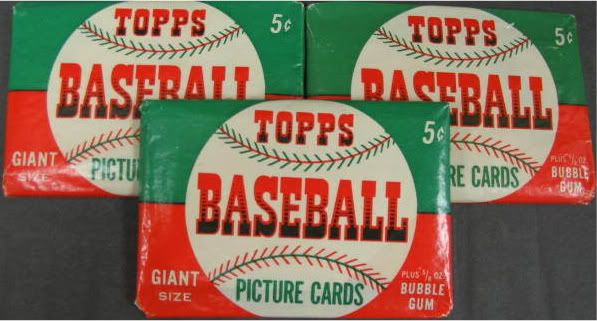

1952 Topps Baseball
- MSRP: 0.05 Cents Per Pack
- Complete Set: 407 Cards
- Checklist
Current Market Price:
- On eBay
- Per Pack: About $1,000 +++
- Per Box: ?????????
Key 1952 Topps Links:
Price Guide App – Tracks Pricing of PSA Graded Sales
eBay – The #1 place to browse, buy & sell ’52 Topps
Complete Checklist
![]() Related Reading + Checklists
Related Reading + Checklists
1953 Topps Review
1951 Topps Review
1952 Topps Baseball is the staple of all things vintage. It’s timeless design, with a set loaded with future Hall of Famers, have kept ’52 Topps in the hearts and minds of collectors for decades. The set was designed by Sy Berger, who famously did most of his work on his living room couch. Berger in this interview with SABR recalls those days at home tirelessly putting the 1952 Topps set together:
“You’ve got to understand, we were neophytes in this, in putting out cards, especially seasonal cards like sports cards. Which I want you to know, I wrote very single one of those 1952 cards. I wrote them and I recalculated the statistics because everything in one book says a guy’s 6 foot 2, in the next book it says he’s 5 foot 11. One says he weighs 300lbs, the other says 200lbs. You know, information wasn’t that ready in those days and I worked and I did everything…the whole series at home.”
What many people don’t know is that Topps had to get signed contracts from every player in order to produce the cards for the 1952 set. Sy Berger was also in charge of those duties. Even during the 1950’s, getting players to sign with Topps proved to be difficult for many reasons. For one, Bowman was the big player in the baseball card hobby at the time. Many players simply did not want to sign with Topps because of their loyalties to Bowman. The biggest hurdle for Topps was the fact that nobody knew who they were. That’s where Berger worked his magic.
“My hope in those days was to go into a clubhouse and sign every guy in the clubhouse. I wanted to sign everybody. Every time a team came to New York or Brooklyn I was there. I brought bubble gum into the clubhouses, I became very friendly with all of the players. I was always around.”
Topps also wooed baseball players with money. At the time, Bowman was paying $100 per year for exclusive contracts with players. Topps came in and offered $125. Even back in the 1950’s players were out to get every last dollar they could. More then anything though, it was Sy Berger who won over players with his friendly demeanor and his positive attitude drew players to sign with Topps.
Berger was not only good at schmoozing ball players, he was also able to get the local New York sports writers and radio hosts to give him plugs and shout-outs. Berger helped establish Topps as a reputable company, and that laid the ground work for the 1952 Topps set.
Unique for it’s time:
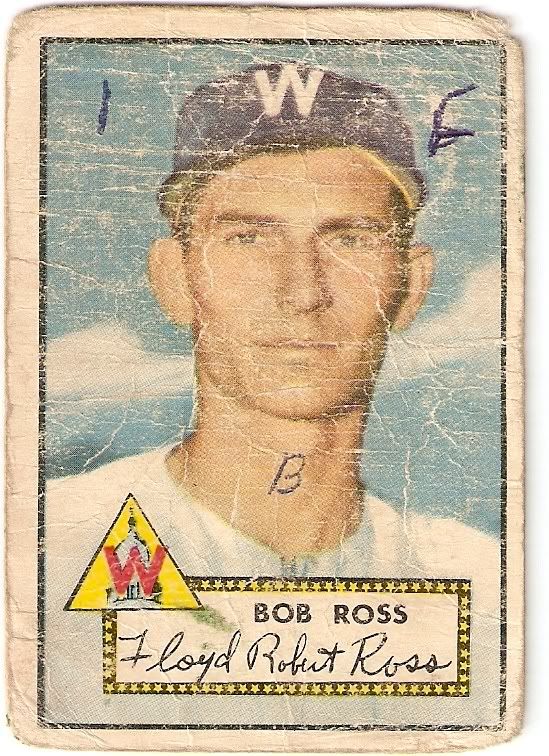
The 1952 Topps Set is revolutionary for it’s time for many reasons. Topps decided to go with a 2 5/8 x 3 3/4 inch card. At the time, they were the biggest cards ever produced for over the counter sale. Also for the first time the MLB team logo was displayed.
Berger felt the Bowman cards of that era were dull and boring. He wanted Topps to stand out and be different. The use of color is the main difference between Bowman and Topps. But it’s the players name and facsimile signature that make 1952 Topps so unique for it’s time.
Today, most of the cards from the 1952 Topps Baseball set look a lot like the Bob Ross card pictured. Many ’52 Topps cards were thrown in the trash by moms across the U.S.
Card backs play a major role:


1952 Topps featured stats on the back of the card. The 1951 stats as well as career statistics were calculated by Berger. His reasoning for using the words “Past Year” for the 1951 stats was because if the cards didn’t sell, Topps was going to try and sell them in 1953.
Berger had to work extra hard to make sure the stats and player descriptions were accurate for the backs of the 1952 Topps set. With no internet, or ESPN, he had to seek out players to get the correct height and weight information.
Cards numbered 1-80 can feature either a red or black back. Red backs are thought to be more prevalent then the black backs.
Two of the more famous error cards came out of the 1952 Topps Baseball set. #48 Joe Page and #49 Johnny Sain have their card backs switched. Topps corrected the error in a later print run with both cards featuring the correct back.
The interesting thing about 1952 Topps is that the set was printed just a handful of cards at a time, meaning not all 407 cards in the set were released at once. As you can see from the different card backs, color and background variations later played a major role when the cards became collectible many decades later. Here is a breakdown of the 6 different print runs of 1952 Topps.
PRINT RUN 1: Cards # 1-80 ‘Low Numbers’
Topps printed the cards on 100 card sheets. To get the first print run to 100 cards they ‘double printed’ 20 cards from the series. A Double Print is a card that was printed in double the quantity compared to the other cards in the same series.
The first run of 1952 Topps included all black backs. It also included the #48 Joe Page and #49 Johnny Sain error cards. In the second wave of printing for the first series, they corrected the Page and Sain error cards and all cards still had the black backs. The final wave of printing saw the debut of the red backs. Topps must have been selling the 1952 set well at the time, because there seems to be more red backs then black backs. Let’s take a look at the key cards from the first print run and be sure to check the link to see if any of the cards are on eBay.
KEY CARDS FROM THE PRINT RUN #1:
– Andy Pafko #1 –
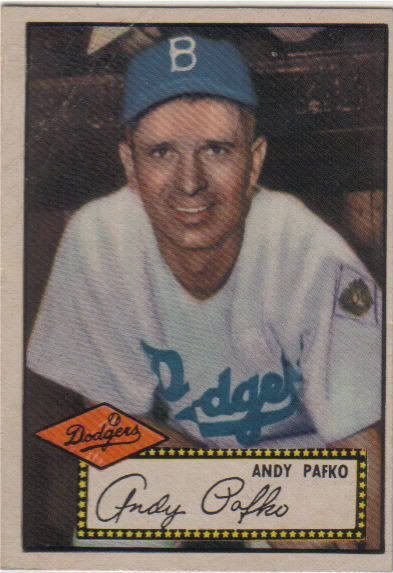
More then anything, the Pafko’s card is popular because it is card #1 in the most popular set of all-time. But Andy had a great MLB career that spanned 17 years and 1,852 games.
Career Line:
BA: .285 HR: 213 -5 Time All-Star-
The Andy Pafko 1952 Topps is a difficult card to find in good condition. It was at the ‘top’ of the printing sheet, which led to poor centering.
– Phil Rizzuto #11 –
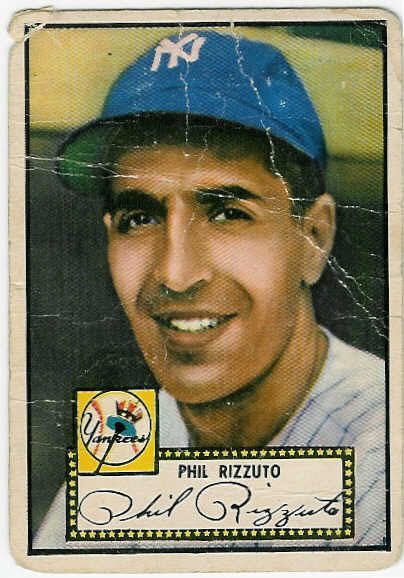
Rizzuto, a New York Yankee legend, appeared on a 1951 Topps card. His 1952 Topps though is by far his most popular card. The 1950 AL MVP was noted throughout his career as a scrappy, hard nosed ball player.
Career Line:
BA: .273 BB: 651 SO: 398
Phil Rizzuto’s 1952 Topps card is a card that every Yankees fan would love to add to their collection.
– Warren Spahn #33 –
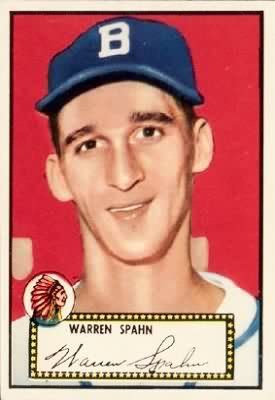
Considered one of the finest pitchers of all time. Spahn won 20 games in a season 13 times. His 363 wins put him 6th all time. Spahn even won 23 games at the age of 42.
Career Line:
W/L: 363-245 ERA: 3.09
Spahn was elected to the baseball Hall of Fame in 1973. His 1952 Topps is one of his most sought after collectibles.
– Gil Hodges #36 –
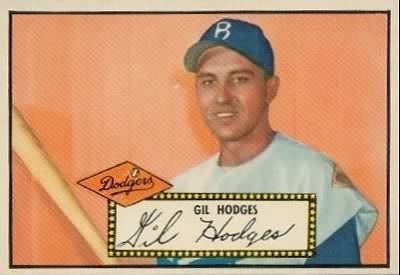
The former Brooklyn and Los Angeles Dodger 1B could do it all on the baseball diamond. He excelled as a hitter and was one of the best defensive players of his era.
Career Line:
BA: .273 HR: 370 -8 Time All-Star-
Hodges is a Dodger favorite even to this day. Couple that with the timeless design of 1952 Topps, it’s no wonder why his card is one of the most popular in the set.
– Duke Snider #37 –

Inducted into the Hall of Fame in 1980, Duke Snider, like Hodges, is one of the most popular Dodger player of all-time. Snider’s #4 is retired by the team.
Career Line:
BA: .295 HR: 407 -8 Time All-Star-
A 1952 Topps Duke Snider #37 is almost impossible to find in good condition. It is probably Snider’s most popular Topps card, so expect to pay a few hundred to get a nice one.
PRINT RUN 2: Cards #81-131
50 single print, and 50 double print cards make up print run #2. I suspected earlier that Topps must have sold the end of print run #1 very well. That theory gets bolstered by the fact that print run #2 are probably the most common 1952 cards on the market today.
KEY CARDS FROM THE PRINT RUN #2:
– Bob Feller #88 –
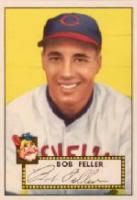
This flame thrower made every at bat uncomfortable for the hitter. There are rumors that Feller could throw the ball over 110 MPH.
Career Line:
W/L: 266–162 ERA: 3.25
The second print run of 1952 Topps didn’t have a lot of big names, and the print run seems to have more cards still on the market today. Nonetheless, getting a Feller #88 would still be a great add to any vintage collection.
PRINT RUN 3: Cards #131-190
20 single print cards and 40 double print cards. The highlight of the 3rd print run is the Billy Martin 1952 Topps Rookie card.
KEY CARDS FROM THE PRINT RUN #3:
– Billy Martin #175 –
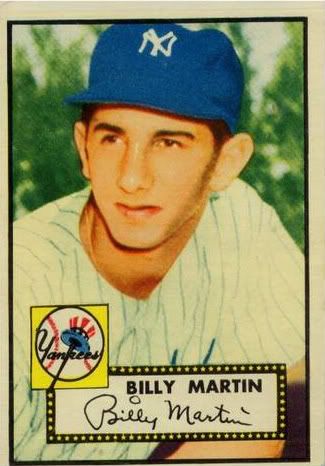
A Yankee legend, Martin probably is better known for his stints as New York’s manager. His bouts with owner George Stienbrener are legendary.
Career Line:
BA: .257 -#1 Retired by the Yankees-
One of the most popular rookies in 1952 Topps, the Billy Martin #175 is a tough card to find in nice condition. It is by far the most sought after card of the 3rd print run.
PRINT RUN 4: Cards #191-250
The 4th print run featured 20 single print cards and 40 double print cards. The highlight of the run is the Yogi Berra #191. The 3rd and 4th print runs are plagued with paper chipping that leads to poor grades. Getting a Berra or Billy Martin card in good condition will fetch big $$$$.
KEY CARDS FROM THE PRINT RUN #4:
– Yogi Berra #191 –
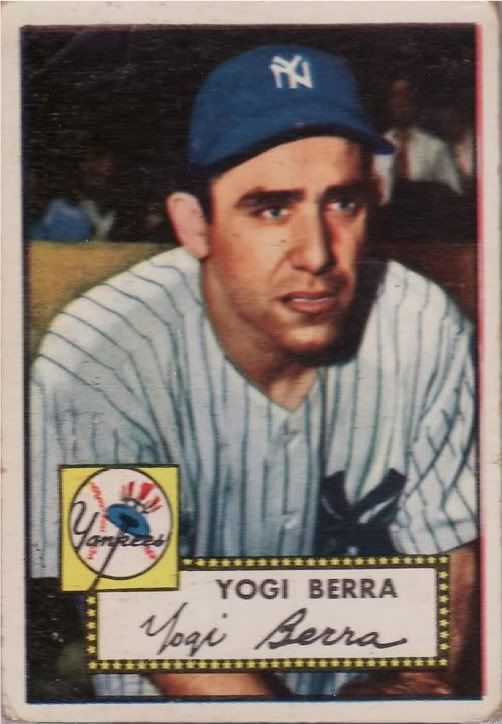
Berra has a bunch of cards on the market, but his 1952 Topps is always one of the favorites amongst collectors.
Career Line:
BA: .285 HR: 358 -15 Time All-Star-
Who wouldn’t want this card. I wouldn’t care if it was all creased up and the back was peeling off. Even if you’re not a fan of the New York Yankees, it’s hard not to like Yogi.
PRINT RUN 5: Cards #251-310
Print run number 5 for the 1952 Topps set had 40 double print cards, numbers 251-280, and 20 single print cards, numbers 301-310. The best card for the print run is the first ever Topps card of San Francisco Giants legend Willie Mays #261.
KEY CARDS FROM THE PRINT RUN #5:
– Willie Mays #261 –

Considered one of the top 5-10 greatest players to ever play the game. Who knows how many Home Runs the Say Hey Kid would have hit if he didn’t play in the windy confines of Candlestick Park.
Career Line:
BA: .302 HR: 660 -24 Time All-Star-
The Mays 1952 Topps is expensive. In January of 2010 a PSA graded 7 sold for $2,661.55. Even in very rough shape like the card pictured here, there is always a demand for Willie.
PRINT RUN 6: Cards #311-407 ‘High Numbers’
The most famous print run of 1952 Topps baseball is by far the sixth series. The run had 94 single print cards and 6 double print cards. Two of the double print cards are the Mickey Mantle #311 and the Jackie Robinson #312.
Topps issued this print run after the baseball season was over. Rumors are they were mostly sold in Canada. Topps had so many left over they even packed them onto a boat and dumped them into the Atlantic Ocean.
KEY CARDS FROM THE PRINT RUN #6:
– Mickey Mantle #311 –

Along with the Honus Wagner T206, the 1952 Topps Mickey Mantle might be the most popular baseball card of all-time. The ’52 Topps is Mantle’s first Topps card, but not considered his rookie because he does have a Bowman issue.
Even ’52 Mantle’s in very poor condition sell for huge money on eBay. A PSA graded 2 sold for $6,700 in 2010. As the market for the 1952 Topps Mantle #311 card goes, so does the market for the other cards in the 1952 set. Here are some good websites to visit to track the price of Mantle’s cards and the other stars in the set:
The Sports Card Reports eBay Hot list tracks the sales of top cards on eBay. They keep track of all the current, and past auctions on eBay so that you can see just how much the 1952 Topps, and other vintage cards are worth.
Of course you’ll always need to be checking out all the 1952 Topps auctions on eBay. Here are the current ones selling right now. Some of the common players are affordable for the average collector. Although getting any star or hall of fame player in good condition will cost hundreds, sometimes thousands of dollars.
– Jackie Robinson #312 –
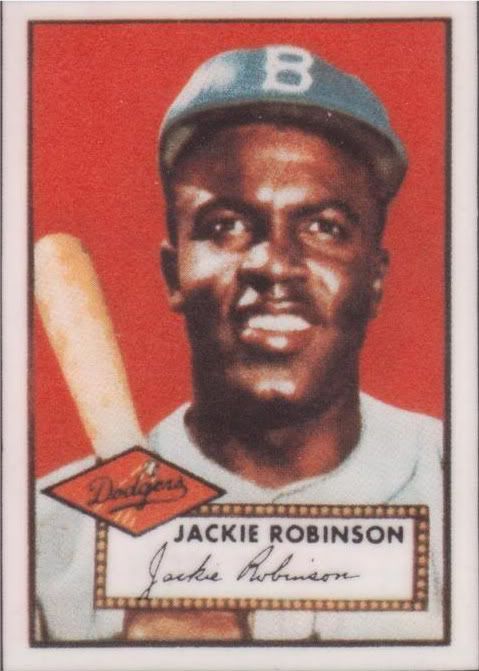
If I somehow stumbled upon a 1952 Topps Mickey Mantle, I would sell it on eBay and pick up a Jackie Robinson #312 and have a few grand left over. Jackie Robinson’s first minor league game after getting signed by the Dodgers brought in 47,000 fans. It didn’t take long for Robinson to get the call to Brooklyn, his talent was undeniable, and he brought along thousands of people to watch him play.
The 1952 Topps Jackie Robinson is his first Topps card. It also might be one of his best looking card as well. As with all ’52 Topps Cards, high grades, 7,8,9, or 10’s will sell for a premium.
Other Top Cards From Print Run 6
– Roy Campanella #314 –
– Pee Wee Reese #333 –
– Hoyt Wilhelm #392 –
– Bill Dickey #400 –
– Eddie Mathews #407 –
The best place to track the price of specific 1952 Topps cards is on eBay. Many of the top cards, with high grades, will end up there. It’s also a great place to pick up some of the common cards as well. The massive 407 card leaves a lot of room for low priced commons.
Complete Checklist
Any card in high grade will sell for very good money. Go check out the Sports Report’s Blog to get a feel for what some of the high grade 1952 Topps cards sell for. A ‘high grade’ is typically a 7,8,9, or 10.

Even the pack wrappers have value. This torn wrapper sold for $26.00. See if there are any wrappers on eBay. You can find either 1 cent, 5 cent, or the rack pack wrappers.

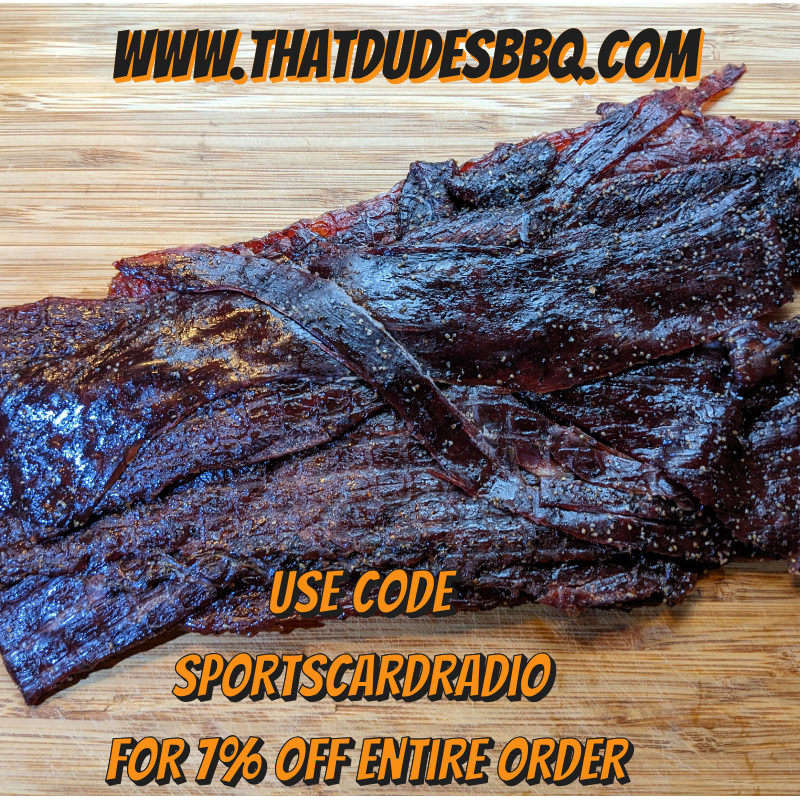
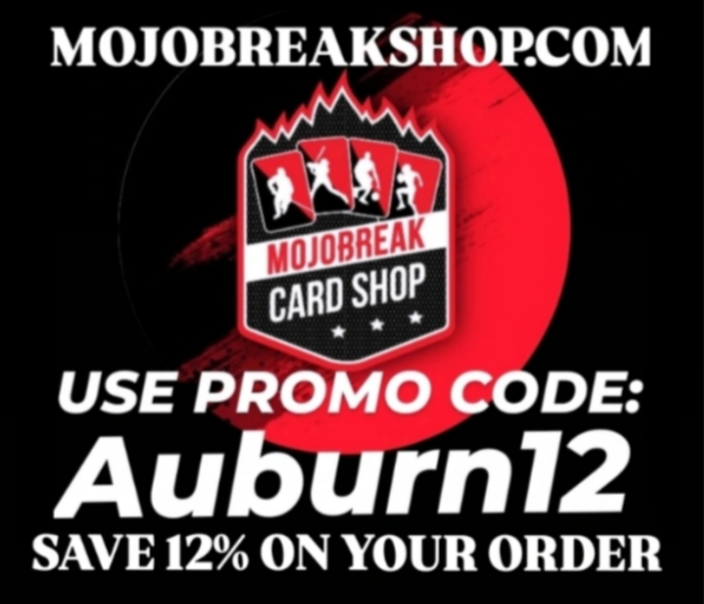

I think the sixth series actually had 97 single print cards and 3 double print cards, 311, 312 and 313.